[/caption]
KENNEDY SPACE CENTER – Despite utilizing just half the work force originally planned and cutting back further on the original test program, Lockheed Martin is now accelerating the Orion Multi-Purpose Crew Vehicle (MPCV) launch schedule and aiming to achieve an Earth orbital flight by 2013 and a human crewed flight as early as 2016. The first Orion crew cabin has been built and construction of the second spacecraft has begun.
What’s more is that a bold “manned mission beyond low Earth orbit and even a lunar fly by is possible in 2016 if NASA’s new heavy lift rocket is developed in time,” says John Karas, vice president of Lockheed Martin’s Human Space Flight programs, in an exclusive interview with Universe Today. A bipartisan majority in Congress recently approved funding for the Heavy lift booster and mandated that the first flight occur in 2016.
“In order to go to the moon, we need NASA’s new heavy lifter,” Karas explained. Orion was designed with the capability to fly human crews to low Earth orbit (LEO) and the International Space Station, as well as beyond to deep space, the Moon, Asteroids, Lagrange Points and Mars.
Orion is NASA’s next generation crew vehicle and is intended to someday replace the Space Shuttle program, which will be fully retired just three months from now.
The second to last shuttle flight – STS 134 – is slated for launch this week on April 29 and President Obama and the entire First Family will attend.
Lockheed Martin is the prime contractor for Orion under a multi-year contract awarded by NASA in 2006.
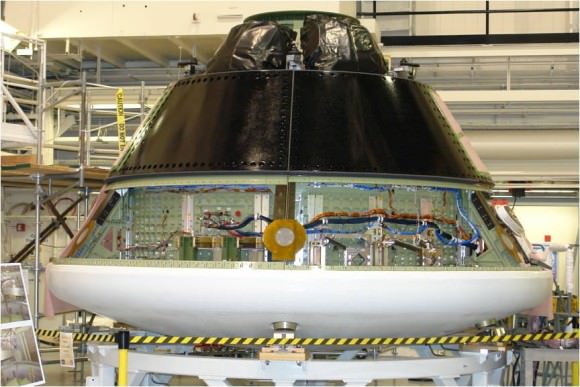
Orion crew module during recent installation of back shell panel at Lockheed Martin’s Vertical Test Facility in Denver, Colorado. Credit: NASA
Karas told me that the streamlined test program would involve flying one Orion mission per year – of increasing complexity – from 2013 to 2016. “Lockheed Martin is working with NASA to determine what are the right launch vehicles and the right missions.”
American astronauts could return to the moon in 5 years after a more than 40 year long hiatus.
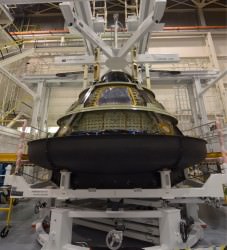
“Right now we are building a brand new crew cabin for the first Orion mission; OFT-1. But everything depends on the budget.”
“For the inaugural Orion test flight in 2013 NASA is considering a Delta IV Heavy booster rocket,” Karas said. “The Atlas V is not powerful enough to send the whole 50,000 pound spacecraft into orbit. With an Atlas we could only launch an Orion crew module. You would have to have delete the Service Module (SM) and /or other subsystems.”
“Orion would be lofted some 7,000 miles out, and then sent back for Earth reentry to simulate something close to lunar velocity, around 80% or so. So we would definitely be testing the deep space environment. Therefore the test flight would be a lot more involved than just a simple Earth orbital reentry.
“For the first Orion mission, we will put as much capability on it as possible depending on the budget,” Karas amplified. “But it’s unlikely to have solar arrays without a few hundred million more bucks. The capability is money limited.”
“The 2014 flight could be a high altitude abort test or perhaps something else.”
“Then a full up unmanned test flight would follow in 2015,” Karas explained.
“If we have a heavy lifter, the 2016 flight with the first human crew could be a deep space mission or a lunar fly by lasting more than a week.”
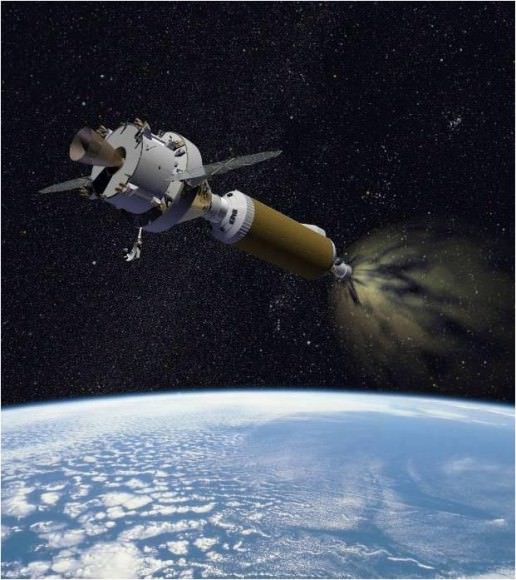
Lockheed has already constructed the initial Orion crew vehicle – known as the first article or Ground Test Article (GTA). The Orion GTA first article was built at NASA’s Michoud Assembly Facility (MAF) in New Orleans, LA where I inspected it after the structural framework was welded into one piece.
Following the installation of mass and volume simulators and a successful series of pressure tests, the first article was then shipped in February this year to the company’s new state-of-the-art Space Operation Simulation Center (SOSC) located in Denver, Colorado.
“At Denver, we are going to finish the assembly of the first article by July of this year so it looks like a spacecraft – adding the doors, windows, thermal tiles and more,” Karas said. “Then it undergoes rigorous acoustics tests until September – known as Shake and Bake – to simulate all aspects of the harsh environment of deep space.”
The next step after that was to send it to NASA Langley for intensive water drop landing tests. But that plan may well change Karas told me.
“The first article – or GTA – is flight worthy. So we don’t want to break the spacecraft during the water landing tests. In the newly revised plan it may be used on the 2nd Orion flight in 2014 instead of reserving it for ground tests only. It would fly with a service module, but not solar panels. The first article could even be the first flight vehicle if the program funding is insufficient.”
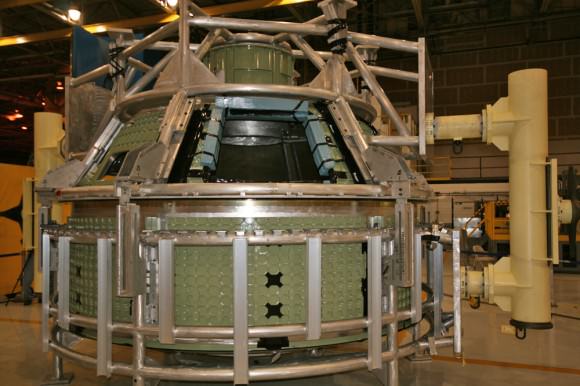
Orion cabin view with astronaut crew hatch and window openings at NASA Michoud Assembly Facility, New Orleans, LA is now undergoing testing and integration at Lockheed’s new state-of-the-art Space Operation Simulation Center (SOSC) in Denver, Colorado. Credit: Ken Kremer
“We have only half the budget for Orion that was planned earlier by NASA,” Karas stated.
“1500 less people are working on Orion since 1 year ago from the start to the end of 2010 – and that number includes all the subcontractors. We had to lay off a lot of people, including some folks we intended to hire.”
“MAF is now focused on building the composite structures of the first Service Module with about 200 people. That’s about half of what should have been about 400 folks. The earlier work at Michoud (MAF) focused on the metallic structures of the cabin for the first article,” said Karas.
To a large degree, launching astronauts to deep space is more a matter of sheer political will power then solving technical issues. And it all comes down to the bucks.
If NASA’s Heavy lifter is not available an alternative scenario with other expendable rockets would have to be developed to achieve the escape velocity required to send a crew of astronauts to the Moon.
Lockheed Martin has independently proposed a stepping stone approach that would send astronauts in Orion spacecraft to challenging deep space targets such as the Moon, and elsewhere such as Asteroids, Lagrange points and Mars that have never been done before and which I’ll feature in upcoming articles.
“Exploration missions that are affordable and sustainable will inevitably lead to technological innovation, to scientific discovery, and to public inspiration and spark an interest in STEM careers that can help the United States counter the overwhelming numerical disadvantage in college graduates it faces in these disciplines in developing third-world nations,’ says Karas.
Read my recent Orion and Shuttle articles:
NASAs First Orion Capsule and New Space Operations Center Unveiled
NASAs First Orion Capsule Ships for Crucial Deep Space Tests
President Obama to Attend Endeavour’s Last Launch on April 29
Shuttle Endeavour Photo Special: On Top of Pad 39A for Final Flight
‘In Flight’ Shuttle Orbiter retirement display planned by Kennedy Space Center Visitor Complex
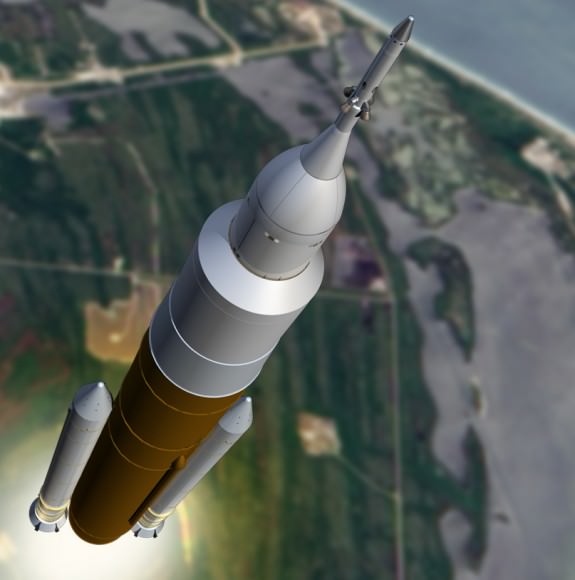
Orion could launch on a lunar flyby mission in 2016 atop NASA’s new Heavy lift booster from the Kennedy Space Center. Credit: Lockheed Martin.

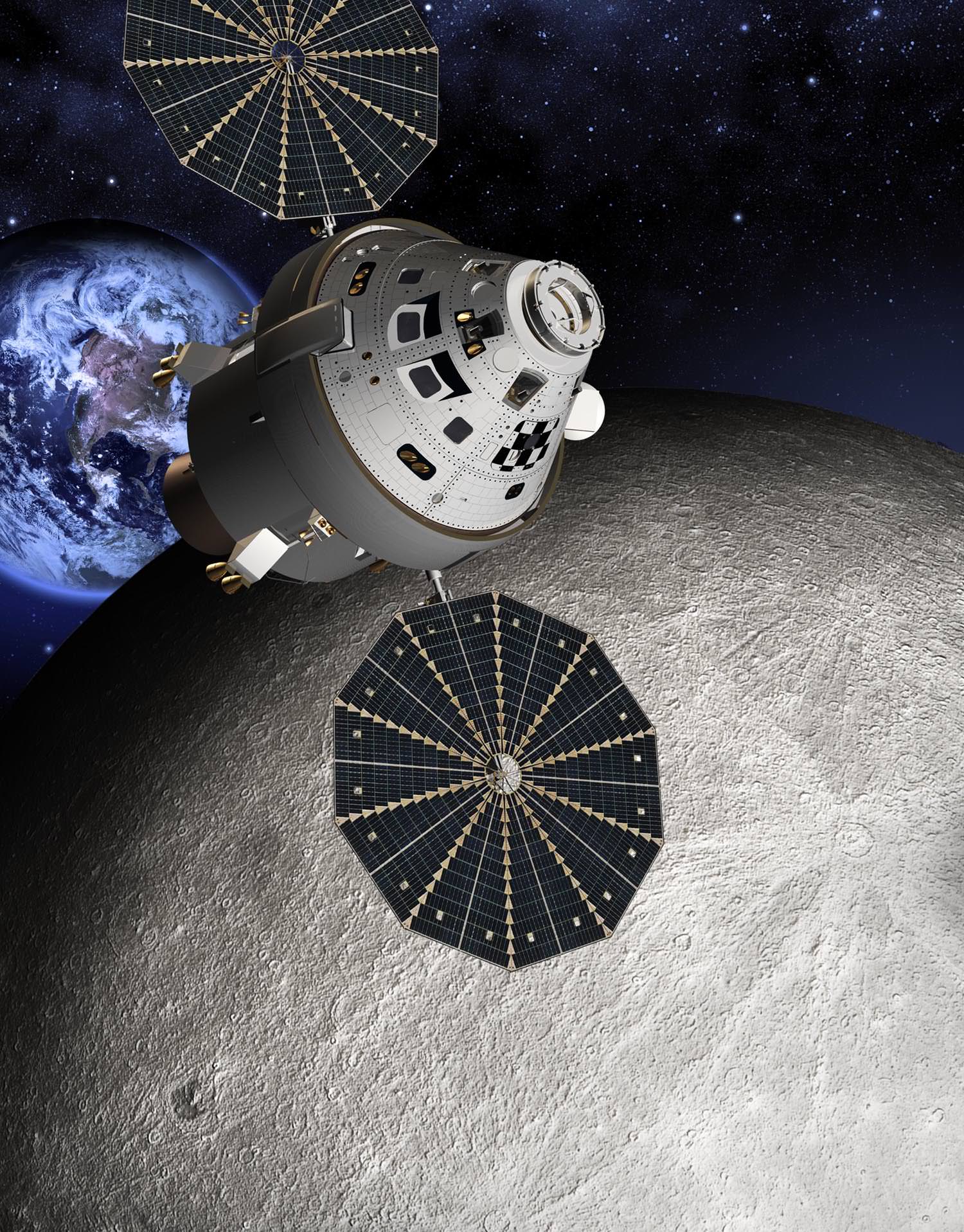
Maybe they could get Elan to launch the Orion for them on his up and coming heavy lifter? Haaa… just saying…. ~@; )
I’m all up for going to the moon.. but for the right reasons. What is the purpose of this mission again? The last paragraph was the only text that hinted at some reasons, but it in itself was quite vague.
Are they just going to deploy some seismometers and geiger counters etc and come back.. I don’t get it.
And I agree with Aqua and a whole lot of other people who wonder why NASA is bothering with heavy launch vehicle development when they could just buy rockets.. literally.. off the shelf.
So quickly we forget. Take a look at what it takes to just get to orbit from earth verses “jumping” off an airless, low gravity, rock like the moon. Anybody remember the “three stage rocket” or large ground support crew needed by the Americans to return from the moon? Not much more then a fire cracker and no ground crew to even wave goodby. A small military base up there and you control the world! You can almost launch the nukes or even, just big rocks with a sling shot/rail gun from an airless, low gravity, world!
Now you know why the old, third, world countries like China are so interested in getting to the moon. He who has the high ground …. rules!
Whatsup
“A small military base up there and you control the world!”
How, exactly?
“You can almost launch the nukes or even, just big rocks with a sling shot/rail gun from an airless, low gravity, world!”
And it’s a long way to go, just to be able to say that.
Rocks or nukes, you’re no longer talking a ‘small military base.’ (as if support of even that much were practical with any near-term transportation capability) What advantage do you get in nuclear or kinetic weapons from the Moon, with a 2-3 day transit time, potentially trackable, plenty of time for retaliation against the base, and/or the nation that creates it (and isn’t that the important part?), that you don’t get with land-based ICBMs that can reach anywhere on Earth in 30 minutes (albeit from known locations), or submarine launched ballistic and/or cruise missiles fired from unknown ocean locations in even less time? (not to mention bombers) If I’m the target, I don’t also have to be able to fling/fire stuff from the Moon, to show my displeasure…
Beyond a certain point, the concept of ‘high ground advantage’ has no meaning (Is Mars even better? Pluto? Alpha Centauri?), and the Moon is over 200,000 miles beyond that point. All the militarily worthwhile stuff is at or within geostationary orbit.
Today, stealth, speed and surprise are more important than ‘high ground.’ Yours is not the way to get it.
Launching a nuke from the Moon?
You could easily shoot it down since it takes 3 days to get to Earth!
And also how the hell did you get it up there?
And the spare parts? How do you get them up there?
@ aerandir and Aqua
As an engineer on the space program, let me point out there there are no rockets available (off the shelf or otherwise) that are human rated except for the current Space Shuttle system. Re-rating an existing commercial rocket, like a Atlas V or Delta IV Heavy, requires a SIGNIFICANT redesign an won’t necessarily get you the capability necessary. It make more sense to develop something new.
And regarding SpaceX’s Dragon and Falcon programs, those don’t even began to come close to meeting NASA’s requirements for human safety, regardless of what Elan says in interviews.
Why couldn’t they meet NASA’s requirements? A Manned Falcon Heavy X or XX should meet NEO needs for manned missions no?
Because they took shortcuts to develop those rockets. Any non-essential parts are not implemented. They also don’t mind that one or 2 rockets blow up since they are covered by insurance.
Adapting the rockets probably requires redesigns.
You can’t design a bus from the plans of a truck.
Did you check out the condition of the Dragon capsule after recovery from orbit? Not bad for the ‘new kid’ on the block! Of course, it will take several successful launches to get the ball rolling………O
Be careful!
This is a commercial company and they are not afraid to cover up things that went wrong and only promote the things that went good. They have to do this because they need investors.
I have serious doubt about the Falcon 9 for example. I think they just got lucky
Currently they are over-hyped. Lets wait and see how many successes they have in the next launches. If one blows up than it is probably over.
Firstly, Kudos to Ken for the exclusive interview.
Operating with1,500 less staff, half the original budget and shortened time lines kinda shows how bloated Lockheed Martin’s original cost-plus program was, despite repeated claims of being “sustainable” and “affordable”. Using the GTA for a test flight instead of building an additional vehicle would have occurred to any fixed-cost pay-for-performance contractor. Still, this is a nice start to improving Orion’s financial performance.
@jean15paul
Um…Soyuz.
Man-rating EELVs like the Atlas V and Delta IV Heavy won’t be cheap, but CCDev winners have few options. Hopefully the get together and just man-rate the Delta splitting the ~$500 million USD cost between Boeing, SNV Corp, Blue Origin and Orion if the Senate Launch System can’t be converted from a paper rocket by 2016.
As an engineer yourself, you might appreciate that Mr Musk, another engineer, has designed Falcon/Dragon with eventual human rating in mind. For example being built to withstand stresses 40% above maximum flight loads. Acessorizing with a launch abort system and other creature comforts are on the way in accordance with NASA’s CCDev expectations.
“And regarding SpaceX’s Dragon and Falcon programs, those don’t even began to come close to meeting NASA’s requirements for human safety, regardless of what Elan says in interviews.”
They can be found here:
http://www.nasa.gov/home/hqnews/2003/jul/HQ_n03069_human_rating.html
Which ones do you think are not being met, despite Falcon 9 having been designed with manned launch in mind?
http://www.thespacereview.com/article/1633/1
Certainly NASA seems content with Falcon 9 tank and interstage structural margins:
http://www1.nasa.gov/offices/c3po/home/F1-S1-Qual-Tank.html
Hah. I had forgotten that the CEV is now the MPCV/SLS.
Well, it’s a bit largish at 5 m vs the Falcon 9/Heavy 3.66 m core (compare to the SRBs 3.71). But certainly the load fairing of Falcon 9 is 5.2 m, and the Ares-1 was supposed to be an longer SRB with a 5.5 m fairing.
[If the SLS use a redesigned ET as discussed, it is an 8.4 m core.]
As for the lift systems, Atlas V or Delta IV Heavy are probably too weak and rattly. 125 % lift capacity vs 140 % for the Falcon 9/Heavy, which is supposed to be the manned requirement. Dunno if they have mechanical launch hold & flame out engine capability, and they were never designed for keeping astronauts from getting their brains bashed out during launch.
Falcon 9/Heavy seems to have better man rating capability than the STS, which had an excellent statistic. IIRC STS had windows without escape/air strip landing capability, none of which would plague a capsule mount.
To place myself in the line of those who doesn’t get the experts claims here:
Let us make a more complete list. STS threw off bits and pieces of itself, onto itself as it launched; Falcon 9 doesn’t seem to release LOX ice even? It stressed the over-designed engines (dual atmosphere/space use – so a compromise) over design [sic!] capacity at 104 (early missions) ~ 110 (late missions) %, IIRC. It used O-rings as they have not been designed for what I know, moving expansion instead of static contraction stresses. And parts of its high tech heat shield came off regularly. (Because NASA wouldn’t buy the more capable Buran shield after its development for some reason. It could take ~ 50 Celsius more _and_ it is claimed stayed on 100 %.)
So I don’t get how Falcon 9 manage to not “even began to come close to meeting NASA’s requirements for human safety” mentioned here. The NASA “Human Rating Requirement and Guidelines for Space Flight Systems” is a framework approach that superficially seems easy enough to ensure. Lots of specific details I’m sure as you run through what NASA has decided this to mean in practice, remember the holdup for the first Falcon 9 launch. But still.
Why the past tense btw, makes it sound from where I sit like there has been some internal review that has set NASA against considering the possible launchers as they develop and prove themselves. I am probably over reading on that, its a word nay a letter difference and a conspiracy theory. Also I hope this is not the case, that isn’t how a project/program/company/agency should be run. Yeah, I’m fishing here; how is NASA run/view on this?
Sorry for the bad english here, I’m changing sleep schedule and _my_ human rating requirements for that are higher than mosts.
Also, it is a unfair to bitch and moan over “could have been” on Buran’s better technology; hard enough to change something that is designed specifically for one vehicle. (Maybe they _did_ look on that option even.) And I should have said “~ 50 Kelvin” in the context (high temp and all).